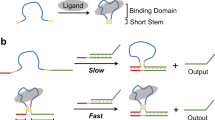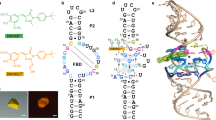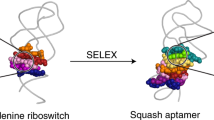Abstract
The long-range communication of information, exemplified by signal transduction through membrane-bound receptors, is a central biochemical function. Reversible binding of a messenger ligand induces a local conformational change that is relayed through the receptor, inducing a chemical effect typically several nanometres from the binding site. We report a synthetic receptor mimic that transmits structural information from a boron-based ligand binding site to a spectroscopic reporter located more than 2 nm away. Reversible binding of a diol ligand to the N-terminal binding site induces a screw-sense preference in a helical oligo(aminoisobutyric acid) foldamer, which is relayed to a reporter group at the remote C-terminus, communicating information about the structure and stereochemistry of the ligand. The reversible nature of boronate esterification was exploited to switch the receptor sequentially between left- and right-handed helices, while the exquisite conformational sensitivity of the helical relay allowed the reporter to differentiate even between purine and pyrimidine nucleosides as ligands.
This is a preview of subscription content, access via your institution
Access options
Subscribe to this journal
Receive 12 print issues and online access
$259.00 per year
only $21.58 per issue
Buy this article
- Purchase on Springer Link
- Instant access to full article PDF
Prices may be subject to local taxes which are calculated during checkout





Similar content being viewed by others
References
Perutz, M. in Mechanisms of Cooperativity and Allosteric Regulation in Proteins (Cambridge Univ. Press, 1990).
Krauss, G. in Biochemistry of Signal Transduction and Regulation (Wiley-VCH, 1999).
Fowler, S. A. & Blackwell, H. E. Structure–function relationships in peptoids: recent advances toward deciphering the structural requirements for biological function. Org. Biomol. Chem. 7, 1508–1524 (2009).
Wittung, P., Nielsen, P. E., Buchardt, O., Egholm, M. & Norden, B. DNA-like double helix formed by peptide nucleic acid. Nature 368, 561–563 (1994).
Dervan, P. B. Molecular recognition of DNA by small molecules. Bioorgan. Med. Chem. 9, 2215–2235 (2001).
Goodchild, J. in Therapeutic Oligonucleotides Vol. 764 (ed. Goodchild, J.) Ch. 1, 1–15 (Humana Press, 2011).
Riddle, J. A., Jiang, X. & Lee, D. Conformational dynamics for chemical sensing: simplicity and diversity. Analyst 133, 417–422 (2008).
Krauss, R., Weinig, H-G., Seydack, M., Bendig, J. & Koert, U. Molecular signal transduction through conformational transmission of a perhydroanthracene transducer. Angew. Chem. Int. Ed. 39, 1835–1837 (2000).
Ousaka, N. & Inai, Y. Transfer of noncovalent chiral information along an optically inactive helical peptide chain: allosteric control of asymmetry of the C-terminal site by external molecule that binds to the N-terminal site. J. Org. Chem. 74, 1429–1439 (2009).
Hill, D. J., Mio, M. J., Prince, R. B., Hughes, T. S. & Moore, J. S. A field guide to foldamers. Chem. Rev. 101, 3893–4012 (2001).
Hecht, S. & Huc, I. in Foldamers (Wiley, 2007).
Yashima, E., Maeda, K., Iida, H., Furusho, Y. & Nagai, K. Helical polymers: synthesis, structures, and functions. Chem. Rev. 109, 6102–6211 (2009).
Nakano, T. & Okamoto, Y. Synthetic helical polymers: conformation and function. Chem. Rev. 101, 4013–4038 (2001).
Green, M. M. et al. Macromolecular stereochemistry: the out-of-proportion influence of optically active comonomers on the conformational characteristics of polyisocyanates. The sergeants and soldiers experiment. J. Am. Chem. Soc. 111, 6452–6454 (1989).
Green, M. M. et al. A helical polymer with a cooperative response to chiral information. Science 268, 1860–1866 (1995).
Yashima, E., Matsushima, T. & Okamoto, Y. Poly((4-carboxyphenyl)acetylene) as a probe for chirality assignment of amines by circular dichroism. J. Am. Chem. Soc. 117, 11596–11597 (1995).
Schlitzer, D. S. & Novak, B. M. Trapped kinetic states, chiral amplification and molecular chaperoning in synthetic polymers: chiral induction in polyguanidines through ion pair interactions. J. Am. Chem. Soc. 120, 2196–2197 (1998).
Clayden, J., Castellanos, A., Solà, J. & Morris, G. A. Quantifying end-to-end conformational communication of chirality through an achiral peptide chain. Angew. Chem. Int. Ed. 48, 5962–5965 (2009).
Dolain, C., Jiang, H., Léger, J-M., Guionneau, P. & Huc, I. Chiral induction in quinoline-derived oligoamide foldamers: assignment of helical handedness and role of steric effects. J. Am. Chem. Soc. 127, 12943–12951 (2005).
Pijper, D. & Feringa, B. L. Molecular transmission: controlling the twist sense of a helical polymer with a single light-driven molecular motor. Angew. Chem. Int. Ed. 46, 3693–3696 (2007).
Ousaka, N., Takeyama, Y., Iida, H. & Yashima, E. Chiral information harvesting in dendritic metallopeptides. Nature Chem. 3, 856–861 (2011).
Ousaka, N., Takeyama, Y. & Yashima, E. Anion-driven reversible switching of metal-centered stereoisomers in metallopeptides. Chem. Eur. J. 19, 4680–4685 (2013).
Solà, J., Fletcher, S. P., Castellanos, A. & Clayden, J. Nanometer-range communication of stereochemical information by reversible switching of molecular helicity. Angew. Chem. Int. Ed. 49, 6836–6839 (2010).
Miyake, H. & Tsukube, H. Coordination chemistry strategies for dynamic helicates: time-programmable chirality switching with labile and inert metal helicates. Chem. Soc. Rev. 41, 6977–6991 (2012).
Crassous, J. Transfer of chirality from ligands to metal centers: recent examples. Chem. Commun. 48, 9687–9695 (2012).
Zhang, D-W., Zhao, X., Hou, J-L. & Li, Z-T. Aromatic amide foldamers: structures, properties, and functions. Chem. Rev. 112, 5271–5316 (2012).
Miyake, H., Kamon, H., Miyahara, I., Sugimoto, H. & Tsukube, H. Time-programmed peptide helix inversion of a synthetic metal complex triggered by an achiral NO3 − anion. J. Am. Chem. Soc. 130, 792–793 (2007).
Clayden, J. Transmission of stereochemical information over nanometre distances in chemical reactions. Chem. Soc. Rev. 38, 817–829 (2009).
James, T. D., Samankumara Sandanayake, K. R. A. & Shinkai, S. Chiral discrimination of monosaccharides using a fluorescent molecular sensor. Nature 374, 345–347 (1995).
James, T. D., Phillips, M. D. & Shinkai, S. in Boronic Acids in Saccharide Recognition (Royal Society of Chemistry, 2006).
Dowlut, M. & Hall, D. G. An improved class of sugar-binding boronic acids, soluble and capable of complexing glycosides in neutral water. J. Am. Chem. Soc. 128, 4226–4227 (2006).
Venkatraman, J., Shankaramma, S. C. & Balaram, P. Design of folded peptides. Chem. Rev. 101, 3131–3152 (2001).
Toniolo, C. & Benedetti, E. The polypeptide 310-helix. Trends Biochem. Sci. 16, 350–353 (1991).
Hummel, R-P., Toniolo, C. & Jung, G. Conformational transitions between enantiomeric 310-helices. Angew. Chem. Int. Ed. 26, 1150–1152 (1987).
Solà, J., Morris, G. A. & Clayden, J. Measuring screw-sense preference in a helical oligomer by comparison of 13C NMR signal separation at slow and fast exchange. J. Am. Chem. Soc. 133, 3712–3715 (2011).
Boddaert, T., Sola, J., Helliwell, M. & Clayden, J. Chemical communication: conductors and insulators of screw-sense preference between helical oligo(aminoisobutyric acid) domains. Chem. Commun. 48, 3397–3399 (2012).
Fletcher, S. P., Solà, J., Holt, D., Brown, R. A. & Clayden, J. Synthesis of enantiomerically enriched (R)-13C-labelled 2-aminoisobutyric acid (Aib) by conformational memory in the alkylation of a derivative of L-alanine. Beilstein J. Org. Chem. 7, 1304–1309 (2011).
Wiskur, S. L. et al. pK a Values and geometries of secondary and tertiary amines complexed to boronic acids—implications for sensor design. Org. Lett. 3, 1311–1314 (2001).
James, T. in Creative Chemical Sensor Systems Vol. 277 (ed. Schrader, T.) Ch. 110, 107–152 (Springer, 2007).
Zhu, L. et al. A structural investigation of the N–B interaction in an o-(N,N-dialkylaminomethyl)arylboronate system. J. Am. Chem. Soc. 128, 1222–1232 (2006).
Collins, B. E. et al. Probing intramolecular B–N interactions in ortho-aminomethyl arylboronic acids. J. Org. Chem. 74, 4055–4060 (2009).
Collins, B. E., Metola, P. & Anslyn, E. V. On the rate of boronate ester formation in ortho-aminomethyl-functionalised phenyl boronic acids. Supramol. Chem. 25, 79–86 (2012).
Pengo, P. et al. Quantitative correlation of solvent polarity with the α-/310-helix equilibrium: a heptapeptide behaves as a solvent-driven molecular spring. Angew. Chem. Int. Ed. 42, 3388–3392 (2003).
Roy, C. D. & Brown, H. C. A comparative study of the relative stability of representative chiral and achiral boronic esters employing transesterification. Monatsh. Chem. 138, 879–887 (2007).
Brown, R. A., Marcelli, T., De Poli, M., Solà, J. & Clayden, J. Induction of unexpected left-handed helicity by an N-terminal L-amino acid in an otherwise achiral peptide chain. Angew. Chem. Int. Ed. 51, 1395–1399 (2012).
Lewis, B. A. & Engelman, D. M. Lipid bilayer thickness varies linearly with acyl chain length in fluid phosphatidylcholine vesicles. J. Mol. Biol. 166, 211–217 (1983).
Xu, F. et al. Structure of an agonist-bound human A2A adenosine receptor. Science 332, 322–327 (2011).
Jaakola, V-P. & Ijzerman, A. P. The crystallographic structure of the human adenosine A2A receptor in a high-affinity antagonist-bound state: implications for GPCR drug screening and design. Curr. Opin. Struct. Biol. 20, 401–414 (2010).
Takeuchi, M., Taguchi, M., Shinmori, H. & Shinkai, S. Molecular design of boronic acid-based dye receptors for nucleosides. Bull. Chem. Soc. Jpn 69, 2613–2618 (1996).
Kobayashi, H., Amaike, M., Koumoto, K. & Shinkai, S. Organization of nucleosides supported by boronic-acid-appended poly(L-lysine): creation of a novel RNA mimic. Bull. Chem. Soc. Jpn 74, 1311–1317 (2001).
Jiang, S. et al. Stereochemical and regiochemical trends in the selective detection of saccharides. J. Am. Chem. Soc. 128, 12221–12228 (2006).
Duggan, P. J. & Offermann, D. A. Remarkably selective saccharide recognition by solid-supported peptide boronic acids. Tetrahedron 65, 109–114 (2009).
Cai, S. X. & Keana, J. F. W. o-Acetamidophenylboronate esters stabilized toward hydrolysis by an intramolecular O–B interaction: potential linkers for selective bioconjugation via vicinal diol moieties of carbohydrates. Bioconj. Chem. 2, 317–322 (1991).
Toniolo, C. & Bruckner, H. E. in Peptaibiotics (Wiley-VCH, 2009).
Acknowledgements
This work was funded by the Biotechnology and Biological Sciences Research Council through a Research Grant (I007962) and a Doctoral Training Grant studentship. The authors thank T. Wallace for donating samples of 6c, 6e and 6f. The authors acknowledge the Engineering and Physical Sciences Research Council National Mass Spectrometry Centre for performing high-resolution mass spectrometry measurements.
Author information
Authors and Affiliations
Contributions
R.A.B., S.J.W. and J.C. conceived and designed the project. R.A.B. and V.D. designed and executed the synthesis of the receptors. R.A.B. performed the analytical studies. R.A.B., S.J.W. and J.C. wrote the paper.
Corresponding authors
Ethics declarations
Competing interests
The authors declare no competing financial interests.
Supplementary information
Supplementary information
Supplementary information (PDF 4849 kb)
Rights and permissions
About this article
Cite this article
Brown, R., Diemer, V., Webb, S. et al. End-to-end conformational communication through a synthetic purinergic receptor by ligand-induced helicity switching. Nature Chem 5, 853–860 (2013). https://doi.org/10.1038/nchem.1747
Received:
Accepted:
Published:
Issue Date:
DOI: https://doi.org/10.1038/nchem.1747
This article is cited by
-
Programming conformational cooperativity to regulate allosteric protein-oligonucleotide signal transduction
Nature Communications (2023)
-
Engineering receptor-mediated transmembrane signaling in artificial and living cells
Communications Materials (2023)
-
Switching imidazole reactivity by dynamic control of tautomer state in an allosteric foldamer
Nature Communications (2023)
-
Controlling supramolecular filament chirality of hydrogel by co-assembly of enantiomeric aromatic peptides
Journal of Nanobiotechnology (2022)
-
Hierarchical communication of chirality for aromatic oligoamide sequences
Nature Communications (2021)



